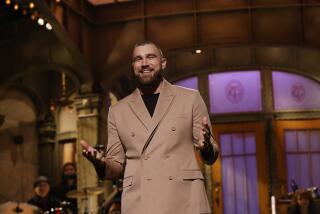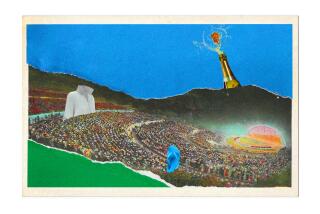Advertisers Hope to Score Big at Super Bowl With Interactive Campaigns
The best way to win money on this year’s Super Bowl might not be by betting on the game. It might be by testing your luck during the commercials.
While highly paid football players are battling it out in the Super Bowl on Jan. 27, free-spending advertisers--paying ABC about $800,000 per 30-second spot--will go at it in the Commercial Bowl. Perhaps this year’s commercial cavalcade should be dubbed the Techno Bowl.
Advertisers ranging from Coca-Cola to Pepsico to Anheuser-Busch have weaved together all sorts of high-tech, interactive ad campaigns that will ask viewers to do more than sit in their seats and slurp beer. Cash prizes of up to $1 million will be handed out to several viewers who take such simple steps as phoning toll-free numbers or holding special game cards in front of their TV screens.
During the game, Pepsi says it will dole out three $1-million prizes on the air. Coke expects to hand out one $1-million prize--along with some Ford Mustang convertibles and free trips to Disney World. And Anheuser-Busch is giving away a $100,000 grand prize--and 5,000 commemorative footballs.
So who needs to place bets on the game?
“Interactive ads could become the dominant part of the festivities,” said Fred Danzig, editor of the trade publication Advertising Age. But if too many copycats try placing interactive Super Bowl ads in years to come, the commercials could become as boring as many of the lopsided Super Bowls, he warned.
“This is a sure-fire device for people who can’t dream up creative Super Bowl ads,” said Los Angeles adman Stan Freberg, president of Freberg Ltd. Freberg said the ad giveaways are frighteningly similar to the free dishes that many movie theaters gave away to attract customers during the Depression. “I can’t believe advertisers have resorted to this.”
But the advertisers insist it’s not a lack of creativity that had led to this strategy but their desire to get more for their money.
Five years ago, it cost about $500,000 to buy a 30-second Super Bowl spot. In a few years, that same half-minute spot probably will cost $1 million. So, instead of spending megabucks to create lavish ads, a growing number of advertisers are putting their money into the technology of ads that try to garner attention by waving cash prizes in the faces of millions of viewers.
Pepsi, for example, has swung a deal with AT&T;, MCI and US Sprint, that will free up some 30,000 phone lines and allow the soft-drink giant to handle up to 3 million phone calls during the course of the football game. Callers will hear a recorded message from singer Ray Charles who will ask them to leave their names, addresses and phone numbers.
A computer will assist operators in randomly selecting three callers who will each win $1 million. Their names will be announced in a commercial to be broadcast right after the game.
Silly stuff? “We don’t think giving consumers the chance to win $1 million is silly at all. We think it’s the most exciting event of the year,” said Pepsi spokeswoman Leigh Curtain. “We hope people will watch the game with a Diet Pepsi in one hand and telephone in the other.”
Meanwhile, Coke has concocted a “Crack the Code” game to air during commercial breaks. Game pieces will be available in stores on specially marked Diet Coke bottles and cans several weeks before the Super Bowl. During halftime of the football game, a special 60-second commercial will allow consumers to “decode” their game pieces by holding them up to their TV sets.
Besides the $1-million grand prize, 1 million additional prizes ranging from the Mustangs to two-liter bottles of Coke will be available. Although the Pepsi contest is a one-shot deal, the Coke competition--which will feature deadpan “Naked Gun” detective Leslie Nielsen--will continue through March.
The latest high-tech venture may be a bit risky for Coke. Two years ago, Coke was widely criticized for a confusing 3-D Super Bowl ad that required viewers to wear special glasses. And a more recent “Magic Can” promotion the company unveiled last year fizzled when problems arose with the mechanics of some of the cans that had money hidden inside.
“We don’t think there will be any problems with this,” said Bertini. “This is not some technological breakthrough. It’s a way of doing something more than just a commercial.”
Meanwhile, for the third consecutive year, Anheuser-Busch will once again broadcast the Bud Bowl. This will include a half-dozen animated TV spots--filmed at Boss Films Studios last month in Marina del Rey--that feature a team of Bud Light beer bottles pitted in a football game against a team of Budweiser bottles.
Viewers are asked to write down the scores flashed on each Bud Bowl ad--which will air every quarter--then mail in completed Bud Bowl score cards after the game. The score cards, of course, will only be available at special displays at stores that sell the brew.
Anheuser-Busch says it will spend about $8 million on the Bud Bowl campaign this year. Are these Bud Bowl games getting a bit out of hand? “Our attitude is, people don’t keep score to win money,” said Tom Sharbaugh, group brand director at Anheuser-Busch. “We’re not trying to recreate the New Jersey Lottery. We’re just trying to have some fun.”
Hoop Star Wins Top Role in L.A. Gear Ad
It might seem as if L.A. Gear has one foot up on most other Super Bowl advertisers. With Joe Montana as a paid spokesman, all the sneaker maker has to do is hope that the San Francisco 49ers make it to the Super Bowl, then ram in as many Joe Montana ads as it can afford. Right?
Wrong. Super Joe won’t even appear in L.A. Gear’s first Super Bowl ad. But Utah Jazz basketball star Carl (Mailman) Malone will. Does L.A. Gear have its sports confused?
Hardly. What it does have is a reasonably good understanding of how to get the most yardage out of exposure during the Super Bowl.
On the day that the football season ends--and basketball season begins to pick up steam--the athletic shoe maker will turn to one of basketball’s premiere players to help it introduce a pricey line of high-tech shoes called “Catapult,” which will try to go head-to-head with Reebok’s “Pump” and Nike’s “Air” shoe lines. The “Street Hiker” line of L.A. Gear shoes that Montana endorses is about a year old.
Over the years, advertisers have come to understand that the Super Bowl is an especially good place to introduce products. Last year, Gillette introduced its “Sensor” line of razors during the Super Bowl and saw its sales jump 30% over what had been forecast.
“We could introduce the shoe on some NCAA basketball game, but that’s not the Super Bowl,” said Sandy Saemann, L.A. Gear’s executive vice president, of the Catapult. “When you’ve got a new product, you’ve got to think big.”
Audi Is Lone Car Maker at NFL Championship
Don’t look for many car commercials in this year’s Super Bowl. In fact, only one automotive advertiser has signed on: Audi of America.
The big auto advertisers from last year’s Super Bowl--General Motors, Nissan and Toyota--have all said thanks, but no thanks. Most say the high price of Super Bowl commercials is scaring them off, and they can get better bargains with other athletic events.
“The cost of Super Bowl ads continues to go up,” said John Rinek, advertising manager at Nissan. “Strategically, we can get more bang for our dollar by going with other programs.”
But Audi, a first-time Super Bowl advertiser, has purchased two 60-second spots. The company will introduce a campaign with the slogan “Take Control.” And the day after the Super Bowl, a 12-page insert ad from Audi will appear in the Wall Street Journal.
“At first glance, you might not think it makes sense,” said Bob Garity, manager of advertising for the car maker. “As expensive as the Super Bowl is, we feel it’s the most efficient way to reach Audi buyers.”
ABC Sees No Lack of Buyers for Costly Spots
How is ABC doing in its sales of Super Bowl commercial air time?
Surprisingly well--especially considering the $800,000 price for each 30-second spot. The network says it has sold 53 of the 56 available 30-second time slots. And it says it has seven advertisers who have stated interest in the three remaining slots. Said an ABC spokeswoman: “We have no doubt we will be sold out soon.”
More to Read
Go beyond the scoreboard
Get the latest on L.A.'s teams in the daily Sports Report newsletter.
You may occasionally receive promotional content from the Los Angeles Times.










